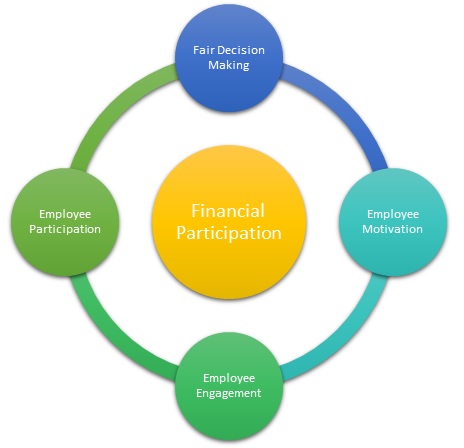- Business Concepts ›
- Human Resources (HR) ›
- Financial Participation
Financial Participation
Definition, Importance & Example
This article covers meaning & overview of Financial Participation from HRM perspective.
What is meant by Financial Participation?
Financial participation is the involvement of employees in the financial decisions of the organizations. The financial participation mainly involves employees to know the decisions regarding profits and also sometimes about the condition of equity capital in an organization.
While employees are considered to be an integral part of an organization, employees say in the finance of the organizations becomes sometimes very important. But all of these again depends on the type of organization. If it follows a mechanistic design and have high levels of organizational hierarchy, then such financial participation is not that visible. The decisions are stuck to the higher authority only. Employees are involved so that they are part of the realities of the financial condition of the organization and believe that the incentives and rewards they getting or the bonus they are getting are based on fair decisions, which they were a true witness to.

Importance of Financial Participation
As we all know organizations are so evolving into designs that encourage employee participation and engagement in every stage. Employees are a part of every decision making process. Financial participation is one of those important concepts which further the participation process of employees. Finance is a very sensitive part of an organization. We all know, the real truth for which every employees work is to earn bread for themselves and their family. Every employee is keen to know how the incentives will be given, how the profits will be shared. Making the employees part of the financial discussions assures them on the basis they are getting their salary all other incentives and helps in their motivation. The financial participation of employees also make them aware about the financial conditions of the organization, which will help them realize how to work ahead so to either better the situation or to make it the best one. Profit sharing and equity capital ownership are the major basis of discussions in financial meetings with employees. Employee participation in finance also makes feel the employees that they are considered to be assets of the organization that is why they are involved in such crucial decisions. Financial participation is a strong point of Agile HR.
Advantages & Disadvantages of Financial Participation
Advantages of financial participation is an organization are:
1. Employee engagement.
2. Fair decisions.
3. Participative environment.
4. Better target fulfilment.
5. Goal orientation increases.
Some disadvantages are as follows:
1. Employees may take undue advantage.
2. May discuss financial decisions with other organizations’ employees.
3. May doubt on the process of discussion.
Example of Financial Participation
For example, let us take that employees are welcomed in every financial discussion through financial participation. They are clearly presented the financial statements of the financial year. The profits are discussed. The cash flow statements analysis is done. The employee gets to know about the financial aspect of the organization. He or she then starts working accordingly. He may change the way he was working. He may try to adopt other methods to increase the profits of the organization. Also involvement of employees will give more views on how to proceed for the next financial year. When incentives and bonus are given to the employee, he is sure that a fair decision was taken and he is not a victim of partiality.
Hence, this concludes the definition of Financial Participation along with its overview.
This article has been researched & authored by the Business Concepts Team which comprises of MBA students, management professionals, and industry experts. It has been reviewed & published by the MBA Skool Team. The content on MBA Skool has been created for educational & academic purpose only.
Browse the definition and meaning of more similar terms. The Management Dictionary covers over 1800 business concepts from 5 categories.
Continue Reading:
What is MBA Skool?About Us
MBA Skool is a Knowledge Resource for Management Students, Aspirants & Professionals.
Business Courses
Quizzes & Skills
Quizzes test your expertise in business and Skill tests evaluate your management traits
Related Content
All Business Sections
Write for Us